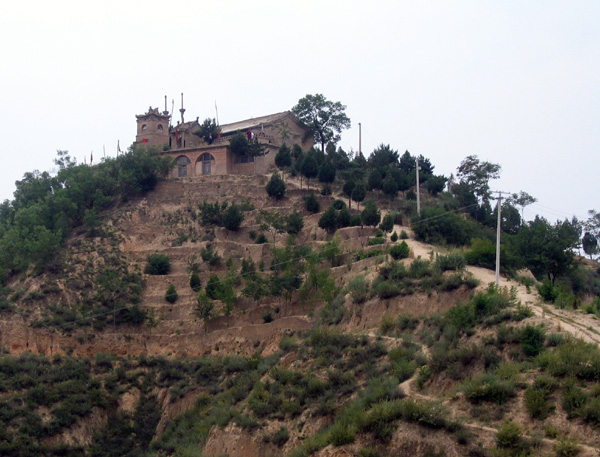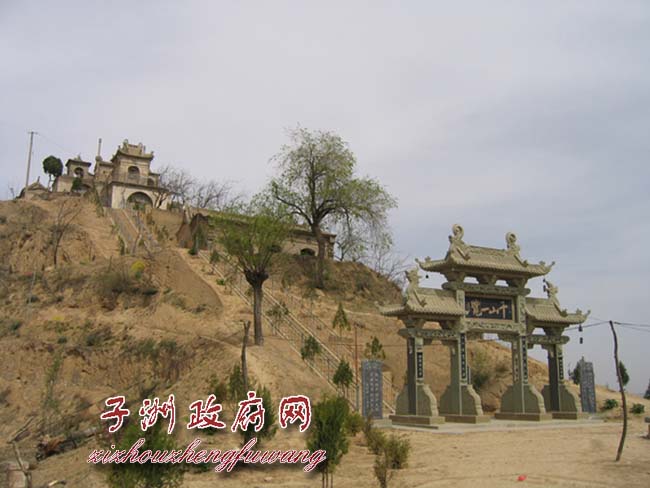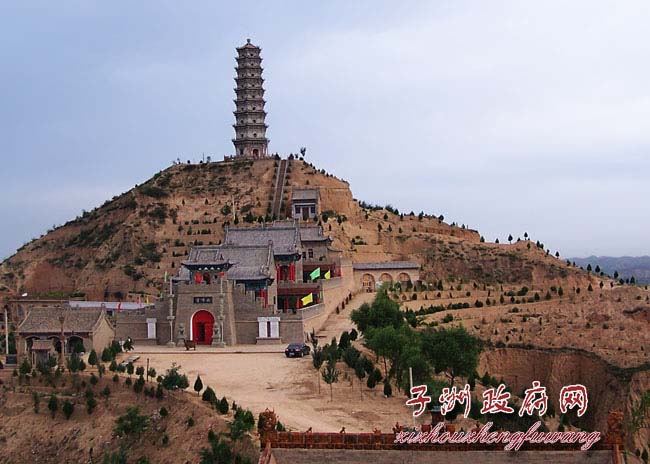The Lupu mountain, Baiquan mountain, Mulian mountain and Niangniang Temple Mountain in Zizhou county are known as "four famous mountains" because of their high mountain situation, special terrain and temples living in groups.
━━━━━━━━━━━━━━━━━━━━━━━━━━━━━━━━
【Lupu mountain】
Lupu mountain is located 3 kilometers northwest of Guayuan zewan township government station. It is famous for the construction of Xinglong temple on its top.
When Xinglong temple was founded cannot be verified. Judging from the inscriptions, the temple became famous during the Xuande period (1426-1436) of the Ming Dynasty. After generation expansion, it now covers an area of nearly 10 mu. It is said that in the early years of the Republic of China, the cultural relics of Xinglong temple were lost one after another, and the walls collapsed from time to time, with several ruins. In the 20th year of the Republic of China (1931), the plague spread in Guayuan zewan, causing serious human and animal death. In order to eliminate the disaster, villagers came to Xinglong temple to pray for divine medicine, and the plague was controlled. In order to repay God's favor, villagers donated money to repair Xinglong temple, and the temple looks new. In the 1980s, Xinglong temple was restored and expanded again, which was more magnificent.

Xinglong Temple faces the south. Most of the buildings are pure brick structure. The halls are arched and the top of the hall is hard mountain style. There are hundreds of stone steps in front of the gate of the temple. The north of the central hall is the main hall, the south is the gate tower, and the East and West are the side halls. The main hall is dedicated to the Buddha, Emperor Haotian and founder Zhenwu. The central hall is dedicated to the ancient Laughing Buddha, Guanyin Bodhisattva, Hunyuan ancestor, and Dharma protector Weituo. The Shanmen tower is composed of three rooms, the bell tower in the East, the drum tower in the West and the Jade Emperor Pavilion in the middle. There is a archway built in recent years under the stone steps of shanmenlou. On both sides of the archway corridor, there are two ferocious looking henha generals. One hundred meters to the east of the archway stands a Changle tower, which is the largest building in Xinglong temple.
Xinglong temple has a small bell in 1587, an iron Qing in 1898, an iron Qing in 1925, 10 scriptures in Tang and Song Dynasties, and a incense burner in Yuan Dynasty.
In 2002-2003, another three-story Pavilion called "Tianwang cave" was built,
[Xinglong Temple meeting]: from March 14 to 16, it is the Guanyin cigarette club;
May 19-21, for the master Guan Gong cigarette Association;
July 17-19, the founder of the cigarette club.
━━━━━━━━━━━━━━━━━━━━━━━━━━━━━━━━
【Baiquan mountain】
Baiquan mountain is located 3 kilometers south of Guayuan zewan township government station. According to legend, there were four big cypress trees with luxuriant branches and leaves in this mountain, so it was named Baiquan mountain.
Baiquan mountain is high in the north and low in the south. There is an ancient temple on the top of the mountain, which mainly worships the emperor of heaven, the emperor of the earth and the emperor of man, and is referred to as the "Sanhuang Temple". In the temple, inscriptions in the 42nd year of Qianlong reign (1764) and the 31st year of Guangxu (1939) in the temple recorded: "it's not very good what Dynasty it was built" and "the year of founding and repairing is far from being verified".

The terraces of Baiquan mountain temple are located in the south, and the lowest terrain of lelou is far away from Sanhuang temple. The next is Niangniang Temple, which is the Bodhisattva Temple of dizang king and the holy King Temple of Mawang. There are more than 100 stone steps behind the Niangniang Temple. When you pick up the steps, you can see the seven temples in Lingshan mountain. There are three pavilions and pavilions for visitors to view from the window. Then the entrance is the Sanhuang temple. The main hall worships the three emperors, while the side hall worships Zhenwu. There are a pair of stone lions, a bronze drum and an iron bell. Under the canopy, there are 6 stone tablets, including 4 in the Qing Dynasty, which are engraved with extreme craftsmanship and have certain cultural value.
[Baiquan mountain temple fair]: March 17-19, for Niangniang cigarette fair;
May 7-9, for the Sanhuang cigarette Club;
July 14-16, the founder of the cigarette club.
━━━━━━━━━━━━━━━━━━━━━━━━━━━━━━━━
【Mu Lian mountain】
Faniu mountain is located 3 kilometers northeast of the government station of Chawan Township, Guayuan. As the name suggests, the mountain is tall and straight, and the plough and the old cattle walking on the mountain will also be tired.
Because of its mountain top set "Mulian Temple", the local people also called it Mulian mountain. It is said that in the early 1960s, the state once built a wooden frame more than 20 meters high beside the Mulian temple. The observers could see the Yellow River more than 200 miles to the East and the city of Xi'an thousands of miles away to the south. It can be seen that the name of this mountain is "Mulian", which is actually "Mulian". However, the article of Mulian in Mulian temple is the abbreviation of Muqian Lianyan. Muqianlianyan is the name of a young man in ancient India. Transliterated in Sanskrit, it is translated into the family of Zashu, Brahman caste. He is one of the ten disciples of Sakyamuni, and is called the first one of the supernatural powers. According to the Yulan basin Sutra, he set up the Yulan basin association to save the mother from the hungry ghost road. Therefore, the story of Mulian saving the mother was also popular in China in the past. The Southern Song Dynasty, Ming Dynasty, Qing Dynasty and modern "Mulian opera" all reflect the process of Mulian's searching for his mother, Madame qingti, and finally rescued his mother by virtue of Buddhism. It praises the character of Mulian who never dares to die despite hardships and hardships.

There are eight stone tablets in Mulian temple. The relic stele was rebuilt in the fifth year of Jiajing in Ming Dynasty. It is difficult to prove when it was founded. The temple is a well preserved ancient temple in Zizhou county. Most of the buildings are pure brick structure, and most of the temple top is hard mountain style. In the main hall, there are three ancient Buddhas, the founder of Zhenwu and the saints of three religions. The central hall worships the ancient Xiaoshi Buddha, Guanyin Bodhisattva, four heavenly kings, Hunyuan ancestor and Dharma protector Weituo. The central hall is flanked by the emperor Guan, Erlang, the great sage of Qitian, the goddess of the third virgin, the king of horse and the earth God. To the side of the hall is the Shanmen tower, which is divided into two floors, and the upper floor is divided into three small towers: the bell tower in the East is hung with an iron bell cast in the 20th year of the Republic of China (1931); in the middle is the Buddha tower, which worships the Jade Emperor and guides the ancient Buddha; and in the west is the drum tower with a metal drum hanging. The lower level is the Shanmen cave, on both sides of the cave there are two generals. Opposite the Shanmen cave is a small elegant building. There are two small temples on the hillside at the foot of the small building. Before the small temple is the theater built in recent years.
According to textual research, many buildings of Mulian temple were built from the 12th to 21st year of the Republic of China, with the style of late Qing Dynasty. Close view of Mount Bainiu, majestic competition, trees, Mulian temple is located during the construction of extraordinary splendor, it can be said that the mountain for the temple to fight for prestige, temple for the mountain to add luster.
[Mulian Temple Association]: from March 11 to 13, it is the ancient Buddha's cigarette club;
August 14-16, for the black tiger Lingguan cigarette Club;
From October 26 to 28, it is a Taoist meeting.
━━━━━━━━━━━━━━━━━━━━━━━━━━━━━━━━
【Mount Niangniang Temple】
Guayuan zewan township government station 3 km northeast of a mountain reed collapse, because the collapse set up Niangniang Temple, it is called Niangniang Temple Mountain.
Niangniang Temple is a hard mountain with an arched hole inside. The eaves of the temple are about 2 meters deep. It is hung with an iron bell weighing 45 Jin in the 58th year of Kangxi (1720). Two stone tablets of the Qing Dynasty are erected. The year of its creation is not possible

Niangniang Temple is located in the northwest and Southeast. It is backed by the valvmao and faces the buzige pagoda, covering an area of about 3 mu. There are 17 statues worshipped in the temple, including the goddess of the third goddess, pink face and gold body. They are dignified, natural and radiant. The little boys are elegant and gentle, with elegant clothes and leisurely shapes. Out of the temple hall for the mountain gate, two stone flagpoles stand in front of the door. One hundred meters to the east of the stone flag is a music tower.
[Niangniang Temple Fair]: from April 7 to 9, it is the nine day lady of heaven cigarette fair.
━━━━━━━━━━━━━━━━━━━━━━━━━━━━━━━━

